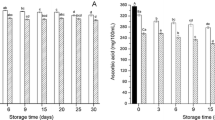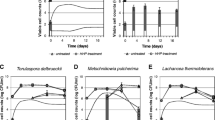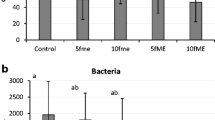Abstract
Vitis vinifera (variety Tempranillo) grapes were subjected to high hydrostatic pressure (HHP) treatments of 200, 400 and 550 MPa for 10 min, and its effect on microbial populations, phenol extraction and wine quality was examined. At ≥400 MPa, the wild yeast population was strongly reduced from 104 to <10 cfu/ml. Bacteria showed greater resistance, and a residual load remained even after the treatment at 550 MPa. The extraction of phenolic compounds from the HHP-treated grapes was improved, with higher concentrations of total phenols obtained compared to crushing alone. Anthocyanin extraction was also increased, producing wines with better colour intensity. These wines also had higher methanol and ethanol contents and returned higher aromatic quality and colour scores. The HHP treatment of grapes may assist in the use of yeast starters, increase phenol extraction from grape skins and improve wine quality.







Similar content being viewed by others
References
Abalos, D., Vejarano, R., Morata, A., González, C., & Suárez-Lepe, J. A. (2011). The use of furfural as a metabolic inhibitor for reducing the alcohol content of model wines. European Food Research and Technology, 232, 663–669.
Baron, A., Denes, J.-M., & Durier, C. (2006). High-pressure treatment of cloudy apple juice. LWT--Food Science and Technology, 39, 1005–1013.
Basak, S., Ramaswamy, H. S., & Piette, J. P. G. (2002). High pressure destruction kinetics of Leuconostoc mesenteroides and Saccharomyces cerevisiae in single strength and concentrated orange juice. Innovative Food Science and Emerging Technologies, 3, 223–231.
Buzrul, S. (2012). High hydrostatic pressure treatment of beer and wine: a review. Innovative Food Science and Emerging Technologies, 13, 1–12.
Castellari, M., Matricardi, L., Arfelli, G., Rovere, P., & Amati, A. (1997). Effects of high pressure processing on polyphenoloxidase enzyme activity of grape musts. Food Chemistry, 60, 647–649.
Chen, X., Li, L., You, Y., Mao, B., Zhao, W., & Zhan, J. (2012). The effects of ultra-high pressure treatment on the phenolic composition of red wine. South African Journal for Enology and Viticulture, 33, 203–213.
Considine, K. M., Kelly, A. L., Fitzgerald, G. F., Hill, C., & Sleator, R. D. (2008). High-pressure processing-effects on microbial food safety and food quality. FEMS Microbiology Letters, 281, 1–9.
Contreras, A., Hidalgo, C., Henschke, P. A., Chambers, P. J., Curtin, C., & Varela, C. (2013). Evaluation of non-Saccharomyces yeast for the reduction of alcohol content in wine. Applied and Environmental Microbiology. doi:10.1128/AEM.03780-13. Published ahead of print 27 December 2013.
Corrales, M., Butz, P., & Tauscher, B. (2008a). Anthocyanin condensation reactions under high hydrostatic pressure. Food Chemistry, 110, 627–635.
Corrales, M., Toepfl, S., Butz, P., Knorr, D., & Tauscher, B. (2008b). Extraction of anthocyanins from grape by-products assisted by ultrasonics, high hydrostatic pressure or pulsed electric fields: a comparison. Innovative Food Science and Emerging Technologies, 9, 85–91.
Corrales, M., Fernández García, A., Butz, P., & Tauscher, B. (2009). Extraction of anthocyanins from grape skins assisted by high hydrostatic pressure. Journal of Food Engineering, 90, 415–421.
Glories, Y. (1984a). La couleur des vins rouges I. Conn Vigne Vin, 18, 195–217.
Glories, Y. (1984b). La couleur des vins rouges II. Conn Vigne Vin, 18, 253–271.
Gonzalez, M. E., Jernstedt, J. A., Slaughter, D. C., & Barret, D. M. (2010). Influence of cell integrity on textural properties of raw, high pressure, and thermally processed onions. Journal of Food Science, 75(7), E409–E416.
Hayakawa, I., Kanno, T., Tomita, M., & Fujio, Y. (1994). Application of high pressure for spore inactivation and protein denaturation. Journal of Food Science, 59, 159–163.
Iizuka, T., Maeda, S., & Shimizu, A. (2013). Removal of pesticide residue in cherry tomato by hydrostatic pressure. Journal of Food Engineering, 116, 796–800.
Lado, B. H., & Yousef, A. E. (2002). Alternative food-preservation technologies: efficacy and mechanisms. Microbes and Infection, 4, 433–440.
Loira, I., Morata, A., González, C., & Suárez-Lepe, J. A. (2012). Selection of glycolytically inefficient yeasts for reducing the alcohol content of wines from hot regions. Food and Bioprocess Technology, 5, 2787–2796.
Loira, I., Vejarano, R., Morata, A., Ricardo-da-Silva, J. M., Laureano, O., González, C., & Suárez-Lepe, J. A. (2013). Effect of Saccharomyces strains on the quality of red wines aged on lees. Food Chemistry, 139, 1044–1051.
Lonvaud-Funel, A. (1999). Lactic acid bacteria in the quality improvement and depreciation of wine. Antonie van Leeuwenhoek, 76, 317–331.
Marx, G., Moody, A., & Bermúdez-Aguirre, D. (2011). A comparative study on the structure of Saccharomyces cerevisiae under nonthermal technologies: high hydrostatic pressure, pulsed electric fields and thermo-sonication. International Journal of Food Microbiology, 151, 327–337.
Mathys, A., Kallmeyer, R., Heinz, V., & Knorr, D. (2008). Impact of dissociation equilibrium shift on bacterial spore inactivation by heat and pressure. Food Control, 19, 1165–1173.
Mok, C., Song, K.-T., Park, Y.-S., Lim, S., Ruan, R., & Chen, P. (2006). High hydrostatic pressure pasteurization of red wine. Journal of Food Science, 71, M265–M269.
Monagas, M., Núñez, V., Bartolomé, B., & Gómez-Cordovés, C. (2003). Anthocyanin-derived pigments in Graciano, Tempranillo, and Cabernet Sauvignon wines produced in Spain. American Journal of Enology and Viticulture, 54, 163–169.
Morata, A. (2010). Nuevas tecnologías de conservación de alimentos. Madrid: Antonio Madrid Vicente. (p. 16).
Morata, A., Benito, S., González, M. C., Palomero, F., Tesfaye, W., & Suárez-Lepe, J. A. (2012a). Cold pasteurization of red wines with high hydrostatic pressure to control Dekkera/Brettanomyces: effect on both aromatic and chromatic quality of wine. European Food Research and Technology, 235, 147–154.
Morata, A., Benito, S., Loira, I., Palomero, F., González, M. C., & Suárez-Lepe, J. A. (2012b). Formation of pyranoanthocyanins by Schizosaccharomyces pombe during the fermentation of red must. International Journal of Food Microbiology, 159, 47–53.
Norton, T., & Sun, D.-W. (2008). Recent advances in the use of high pressure as an effective processing technique in the food industry. Food Bioprocess Technology, 1, 2–34.
Puig, A., Vilavella, M., Daoudi, L., Guamis, B., & Minguez, S. (2003). Microbiological and biochemical stabilization of wines using the high pressure technique. Bulletin del l’OIV, 76, 596–617.
Rapeanu, G., Van Loey, A., Smout, C., & Hendrickx, M. (2005). Thermal and high-pressure inactivation kinetics of polyphenol oxidase in Victoria grape must. Journal of Agricultural and Food Chemistry, 53, 2988–2994.
Santos, M. C., Nunes, C., Cappelle, J., Gonçalves, F. J., Rodrigues, A., Saraiva, J. A., & Coimbra, M. A. (2013). Effect of high pressure treatments on the physicochemical properties of a sulphur dioxide-free red wine. Food Chemistry, 141, 2558–2566.
Shimada, S., Andou, M., Naito, N., Yamada, N., Osumi, M., & Hayashi, R. (1993). Effects of hydrostatic pressure on the ultrastructure and leakage of internal substances in the yeast Saccharomyces cerevisiae. Applied Microbiology and Biotechnology, 40, 23–131.
Tao, Y., Sun, D.-W., Górecki, A., Błaszczak, W., Lamparski, G., Amarowicz, R., Fornal, J., & Jeliński, T. (2012). Effects of high hydrostatic pressure processing on the physicochemical and sensorial properties of a red wine. Innovative Food Science and Emerging Technologies, 16, 409–416.
Terefe, N. S., Matthies, K., Simons, L., & Versteeg, C. (2009). Combined high pressure-mild temperature processing for optimal retention of physical and nutritional quality of strawberries (Fragaria × ananassa). Innovative Food Science and Emerging Technologies, 10, 297–307.
Trujillo, A. J., Capellas, M., Saldo, J., Gervilla, R., & Guamis, B. (2002). Applications of high-hydrostatic pressure on milk and dairy products: a review. Innovative Food Science and Emerging Technologies, 3, 295–307.
Weemaes, C., Ludikhuyze, L., Van Den Broeck, I., & Hendrickx, M. (1998). High pressure inactivation of polyphenoloxidases. Journal of Food Science, 63, 1–5.
Yen, G. C., & Lin, H. T. (1996). Comparison of high pressure treatment and thermal pasteurization effects on the quality and shelf life of guava puree. International Journal of Food Science and Technology, 31, 205–213.
Acknowledgments
This work was funded by the Ministerio de Economía y Competitividad (AGL2013-40503-R). The authors thank S. Somolinos, J. A. Sánchez (Dept. Tecnología de Alimentos), A. Villa, P. Santos (Dept. Biotecnología) and R. Domínguez (ICTAN, CSIC) for excellent technical assistance.
Author information
Authors and Affiliations
Corresponding author
Rights and permissions
About this article
Cite this article
Morata, A., Loira, I., Vejarano, R. et al. Grape Processing by High Hydrostatic Pressure: Effect on Microbial Populations, Phenol Extraction and Wine Quality. Food Bioprocess Technol 8, 277–286 (2015). https://doi.org/10.1007/s11947-014-1405-8
Received:
Accepted:
Published:
Issue Date:
DOI: https://doi.org/10.1007/s11947-014-1405-8




